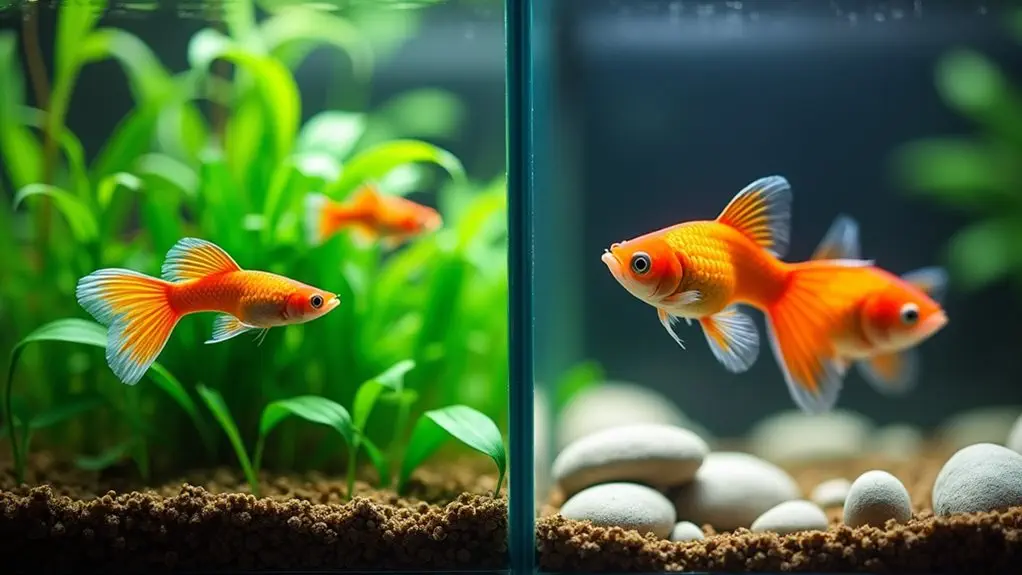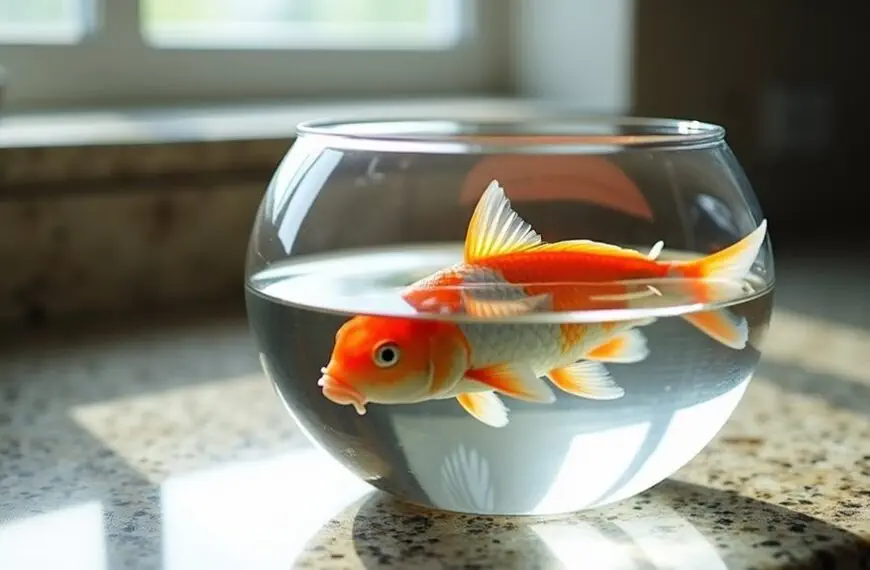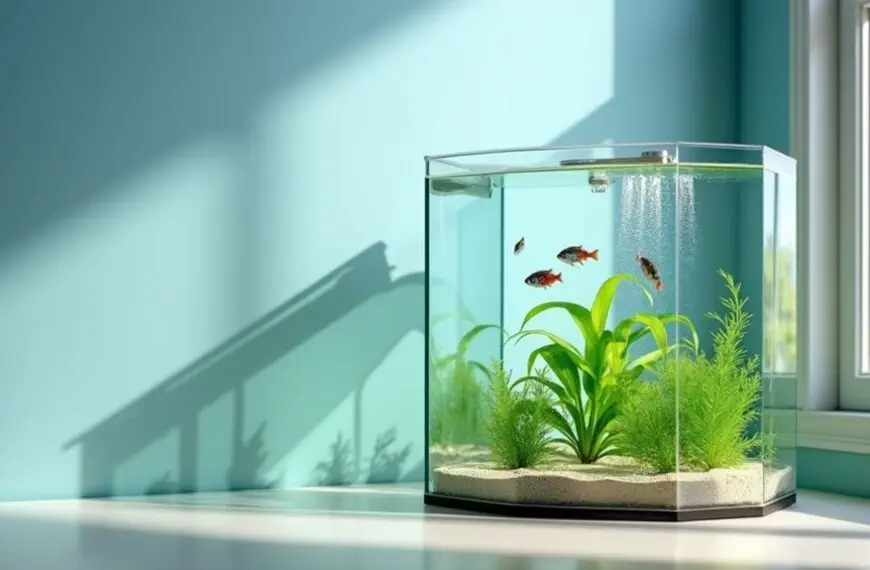You'll want to avoid keeping guppies and goldfish together, as they have very different care requirements that make them incompatible tankmates. Guppies thrive in warmer waters (72-82°F) while goldfish prefer cooler temperatures (68-74°F). There's also a size issue – goldfish grow much larger and might view your guppies as tasty snacks! Goldfish need at least 30 gallons of space and produce lots of waste, while guppies are happy in smaller, cleaner tanks. These fundamental differences in temperature, space, and behavior mean it's best to house these fish separately. Let's explore some better tankmate options for both species.
Contents
- 1 Understanding Guppies and Goldfish
- 2 Tank Space Requirements
- 3 Water Quality and Parameters
- 4 Feeding Habits and Competition
- 5 Behavioral Dynamics Between Species
- 6 Creating Safe Living Spaces
- 7 Plant Selection and Care
- 8 Health and Longevity Considerations
- 9 Best Tank Maintenance Practices
- 10 Frequently Asked Questions
- 10.1 Will Goldfish Eat Guppy Fry if They Breed in the Tank?
- 10.2 Can Guppies and Goldfish Share the Same Medication During Illness?
- 10.3 Do Goldfish and Guppies Compete for Sleeping Spaces at Night?
- 10.4 Should Guppies and Goldfish Be Introduced to the Tank Simultaneously?
- 10.5 Can Temperature Fluctuations Affect One Species More Than the Other?
- 11 Final Thoughts
Understanding Guppies and Goldfish

Guppies and goldfish's contrasting characteristics make them challenging aquarium companions. Through behavioral observations, you'll notice that while both species are generally peaceful, they've distinct needs that can create compatibility challenges.
Their reproductive methods differ, with guppies giving live birth while goldfish lay eggs that are fertilized externally. Guppies thrive in warmer waters between 72-82°F, while goldfish prefer cooler temperatures around 68-74°F. You'll find that these fish are like neighbors who can't agree on the thermostat setting! A higher temperature of 82 degrees Fahrenheit will boost guppy growth but reduce their overall lifespan.
Beyond temperature preferences, they've got different ideas about their ideal living space too. Guppies are content in a cozy 5-gallon tank for a small group, but goldfish need much more room to stretch their fins – at least 30 gallons.
And here's where things get tricky: goldfish aren't exactly picky eaters, and they might mistake your tiny guppies for a tasty snack!
When it comes to water chemistry, you're looking at another obstacle. While both fish appreciate hard water, guppies lean toward slightly alkaline conditions, and goldfish tend to make their environment more acidic.
It's like trying to create the perfect compromise in a shared living space – possible, but definitely requiring some careful planning!
Tank Space Requirements
When it comes to tank space, you'll need to think big for successful cohabitation. A minimum 30-gallon tank is essential when combining these fish, though bigger is definitely better. Think of it as giving your finned friends their own underwater apartment complex! Maintaining a temperature of 72-75°F helps both species thrive in their shared environment.
Space allocation is vital for both species to thrive. If you're keeping fancy goldfish, you'll need at least a 120cm x 50cm x 50cm tank, while common goldfish require even more room – we're talking 200cm x 60cm x 60cm minimum. Since goldfish can live for over 25 years, proper space planning is crucial for their long-term health. Additionally, it's important to remember that water quality parameters should be regularly monitored to ensure both species are healthy.
For guppies, remember they're prolific breeders, so what starts as enough space can quickly become cramped.
Don't forget to include plenty of plants and hiding spots in your setup. You'll want to create distinct zones where smaller guppies can escape when needed, especially since goldfish can grow quite large and might see their tank mates as tasty snacks.
Java moss and water sprite are perfect for creating these safe havens. Remember the six times length rule for goldfish – they need a tank that's at least six times their adult length for comfortable swimming.
Water Quality and Parameters
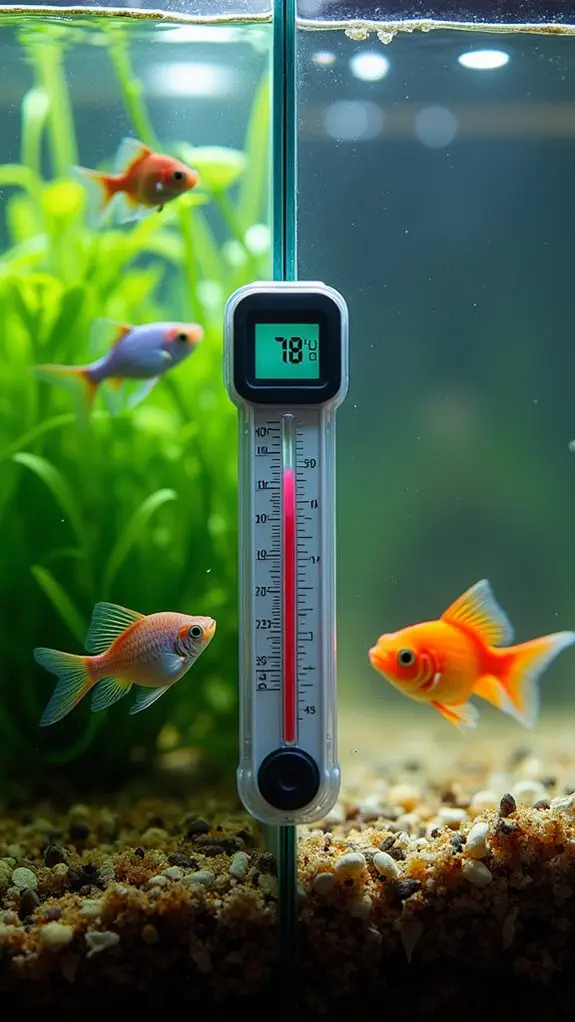
When you're setting up a tank for both guppies and goldfish, you'll need to strike a careful balance with your water parameters, especially since these fish have different comfort zones for pH levels and temperatures.
You can maintain a happy medium by keeping the temperature around 72-74°F and the pH close to neutral (7.0), though you'll want to monitor these levels closely with regular testing. Guppies can adapt surprisingly well to various conditions, with their natural ability to thrive in pH ranges 6-9. A reliable filtration system that processes the tank water at least four times per hour is essential for maintaining water quality, as it helps manage nitrate levels effectively.
Since goldfish are known to be messier than their guppy tankmates, you'll need to be extra diligent with your water changes (aim for 25% weekly) to keep those nitrate and nitrite levels in check for everyone's health and happiness.
Ph Balance Requirements
Understanding pH balance requirements is essential when keeping guppies and goldfish together.
You'll need to monitor pH levels regularly using reliable test kits, as stability is critical for both species' health. Think of pH testing as taking your fish's temperature – it's a significant sign you can't ignore! Weekly pH testing with test strips or solutions is recommended for maintaining optimal conditions.
While guppies prefer slightly alkaline water with a pH of 7-8, goldfish tend to thrive in more acidic conditions. Both species flourish in hard water conditions due to their natural mineral requirements. Maintaining the right pH is crucial because abnormal pH levels can lead to stress and health issues in aquatic life.
You'll find that meeting in the middle at a neutral pH of 7 can work as a compromise for both species. If you need to adjust the pH, you've got several options: baking soda or crushed coral can raise it, while peat moss can lower it.
Just remember to make changes gradually – no more than 0.5 pH units per day.
What's most important isn't hitting a perfect pH number but maintaining consistency.
Sudden pH swings can stress your fish and weaken their immune systems. Regular water changes and proper monitoring will help keep your aquatic friends healthy and happy.
Adding live plants can also help stabilize pH levels naturally by absorbing fish waste.
Water Temperature Ranges
Beyond pH levels, water temperature plays a key role in keeping guppies and goldfish healthy together. When it comes to temperature compatibility, you'll need to find the sweet spot that works for both species.
Guppies thrive in warmer waters between 72-82°F, while goldfish prefer it a bit cooler at 68-74°F. Consistent temperature maintenance is crucial for preventing stress and illness in both species. It's important to remember that stable water parameters can be vital in preventing health complications for your fish. Think of it as trying to make both your hot-natured friend and cold-natured friend comfortable in the same room!
The good news is that there's a workable overlap between these species adaptation ranges: 72-74°F. A 5+ gallon tank is essential for maintaining these temperature requirements. You'll want to maintain this range consistently, as temperature fluctuations can stress your fish out (and nobody likes stressed-out roommates!).
To achieve this, you'll need a reliable aquatic heater with a thermostat – it's like having a smart thermostat for your fish!
Keep in mind that larger tanks make temperature management easier, as they're less prone to sudden changes. You'll want to monitor the temperature daily and make gradual adjustments when needed.
Regular water changes also help maintain stable conditions, ensuring both your guppies and goldfish can swim happily together.
Waste Management Solutions
Managing waste effectively becomes essential in a tank housing both guppies and goldfish, as these two species have different impacts on water quality.
You'll need to be especially mindful since goldfish are like tiny waste factories, producing much more than their smaller tank mates.
To maintain a healthy environment, you'll want to focus on waste reduction through a combination of strategies.
First, install reliable filtration systems that can handle the heavy waste load from your goldfish. Then, add fast-growing plants like water wisteria and java fern, which act as natural water purifiers by absorbing excess nutrients and harmful compounds.
Don't forget about your weekly water changes – they're vital for keeping ammonia levels in check.
Your guppies will thank you, as they're particularly sensitive to poor water quality. A larger tank size will also help dilute waste and give you more wiggle room with water parameters.
Think of it as giving your fish a spacious apartment instead of a cramped studio! Regularly test key parameters such as ammonia levels to ensure a safe habitat.
Monitor your water regularly, and you'll create a balanced ecosystem where both your goldfish and guppies can thrive together.
Feeding Habits and Competition
When you're feeding both guppies and goldfish in the same tank, you'll need to be strategic about meal timing since goldfish can quickly outcompete their smaller tankmates.
While your goldfish will happily gobble up just about anything you drop in the tank, your guppies are pickier eaters who'll need special attention to guarantee they're getting enough high-protein foods like brine shrimp and bloodworms.
You'll want to feed your fish twice daily, but remember that guppies only need portions equal to one-eighth of their body weight, while goldfish can handle more substantial meals. It's also important to monitor the water quality regularly, especially since overfeeding can lead to pollution in the tank.
Meal Timing and Portions
Throughout the day, guppies and goldfish have distinctly different feeding requirements that you'll need to balance carefully. When it comes to meal frequency, you'll want to feed your guppies small amounts two to three times daily, while goldfish can be more flexible with their feeding schedule. Proper portion control is vital – only offer what your fish can consume within 1-2 minutes to maintain good water quality.
You'll need to be extra vigilant when feeding these fish together, as goldfish are notorious food hogs who'll happily gobble up everything in sight! To guarantee your guppies don't go hungry, try feeding them in separate areas of the tank or using different feeding methods. Live foods like brine shrimp can be particularly helpful, as they allow both species to hunt naturally and get their fair share.
For the best results, establish a consistent feeding routine – perhaps morning and afternoon meals – and watch closely to make sure your guppies aren't getting outcompeted. Additionally, maintaining good water quality through regular water changes will help support the health of both your guppies and goldfish in a shared environment.
Food Type Preferences
The dinner table becomes a battleground when guppies and goldfish share the same tank. Your guppy diet requires careful planning, as these little swimmers need a varied menu of flakes, pellets, and freeze-dried foods to remain healthy.
Meanwhile, your goldfish's appetite is like that of a teenager – they'll eat just about anything you put in front of them!
When it comes to food preferences, guppies are more like fine diners who need specific nutrients from both plant and animal sources. They'll happily munch on brine shrimp, bloodworms, and even cucumber slices.
Goldfish, on the other hand, are more like buffet enthusiasts who'll devour whatever crosses their path, including fast-growing plants and standard fish flakes.
To keep the peace, you'll need smart feeding strategies. Consider creating separate feeding zones or scheduling different meal times for each species.
You might also want to use feeding rings for your guppies to guarantee they get their share before their larger tankmates swoop in. Additionally, be mindful that guppies thrive in water conditions with a pH range of 6.8-7.8, which can affect their overall health and compatibility with goldfish.
Behavioral Dynamics Between Species
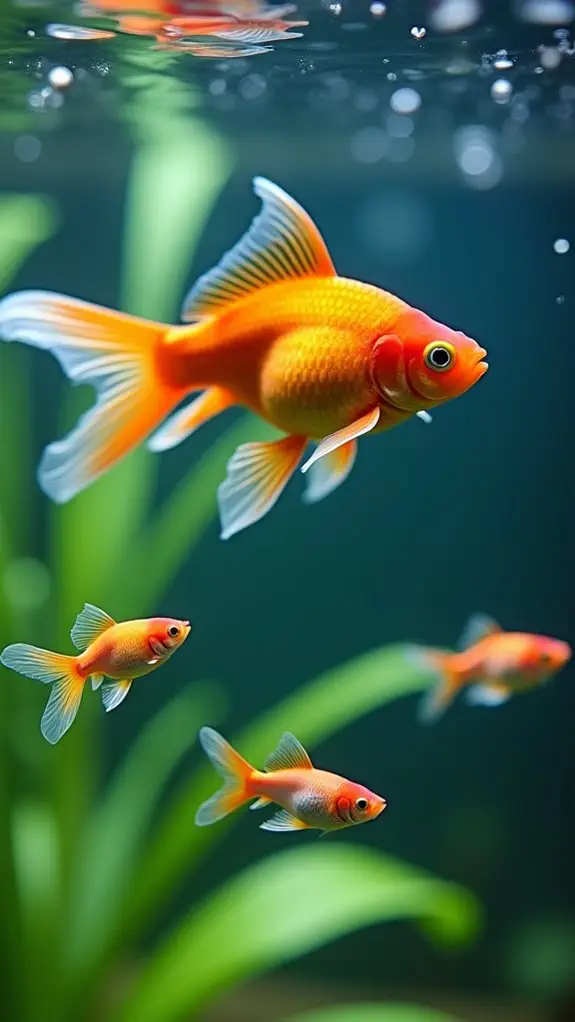
Living together in an aquarium, guppies and goldfish display complex behavioral dynamics that can make their coexistence challenging. Their behavioral compatibility isn't ideal, as these fish come from different temperature preferences and exhibit distinct social patterns.
You'll notice that aggression triggers can include competition for food, space limitations, and territorial disputes. If you're planning to keep these fish together, you'll need to carefully monitor their interactions. Goldfish can become predatory toward guppies, especially when they're hungry or outgrowing their space.
Your guppies might show signs of stress by hiding more frequently or engaging in excessive tail-chasing behavior. Don't be surprised if you see your male guppies performing their signature courtship displays, even in the presence of goldfish – it's just part of their nature!
To minimize conflicts, you'll want to provide a spacious environment of at least 30 gallons with plenty of fast-growing plants for shelter. This setup helps reduce aggression and gives your guppies safe spaces to retreat when they're feeling threatened. Additionally, maintaining suitable water quality management is crucial to ensure a thriving environment for both species.
Creating Safe Living Spaces
Setting up a proper living space builds on these behavioral patterns by creating an environment where both species can thrive.
You'll need at least a 30-gallon tank to give your fish enough room to establish their territories and avoid unnecessary stress. Think of it as giving your finned friends their own underwater neighborhoods!
When it comes to tank design, you'll want to create plenty of hiding spots using plants like java fern and water sprite.
These plants aren't just decorative – they're essential safe zones where your guppies can retreat when they're feeling shy or need a break from their larger tank mates. Floating plants with trailing roots are particularly helpful, as they provide natural cover while adding visual interest to your aquarium.
Remember to maintain a water temperature between 72-74°F, which keeps both species comfortable. Additionally, ensure that you have a quality filtration system to keep the water clean, as this is vital for maintaining fish health.
You'll also need a robust filtration system since goldfish are known for being messy roommates. Regular water changes and maintaining neutral pH levels will help guarantee your underwater community stays healthy and happy.
With these careful considerations, you can create a harmonious home where both species can coexist peacefully.
Plant Selection and Care
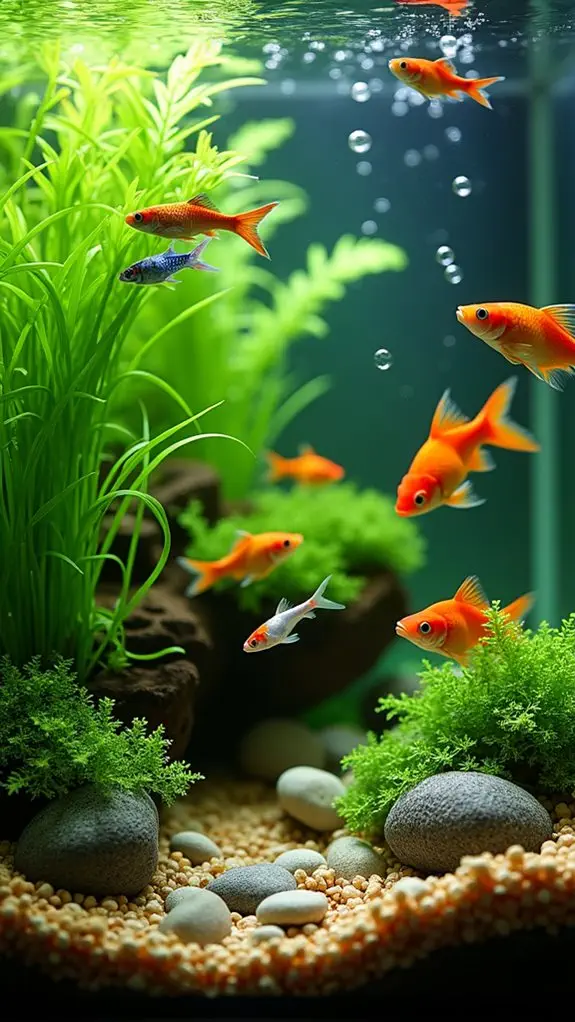
Choosing the right plants for your guppy and goldfish aquarium requires careful consideration of both species' needs. When it comes to plant compatibility, you'll want to focus on hardy varieties that can thrive in water temperatures between 72°F and 76°F, such as water wisteria, cryptocurine, and Vallisneria.
You'll find that creating stunning aquatic aesthetics isn't just about looks – it's about functionality too. Fast-growing plants like Java moss and Amazon frogbit will help maintain water quality by absorbing fish waste and nitrates. Plus, they'll give your guppies plenty of hiding spots when they need a break from their larger tank mates!
To keep your underwater garden thriving, you'll need to maintain a neutral pH around 7.0, which works perfectly for both fish species.
Don't forget to arrange your plants strategically – tall plants like Elodea and Pogo stamina erectus in the background, with floating plants scattered throughout. Regular water changes and pH testing will guarantee your aquatic paradise stays healthy and vibrant.
Health and Longevity Considerations
While a well-planted tank provides a healthy foundation, understanding the health and longevity challenges of keeping guppies with goldfish can make or break your aquarium's success.
When considering these unlikely roommates, you'll need to weigh several health risks, including their different temperature preferences and potential disease transmission between species.
Let's talk about the lifespan comparison – your goldfish could live up to 10 years, while your guppies typically check out after 2-5 years.
You'll want to maintain a delicate balance in their shared home, keeping the temperature around 76°F and the pH neutral to keep both species comfortable. Think of it like finding the perfect thermostat setting that keeps everyone in your house happy!
To minimize stress and health issues, you'll need at least a 30-gallon tank – these fish need their personal space, just like teenagers!
Regular water changes and careful monitoring of tank conditions are essential. If you're noticing any signs of stress, don't hesitate to use tank dividers.
Best Tank Maintenance Practices
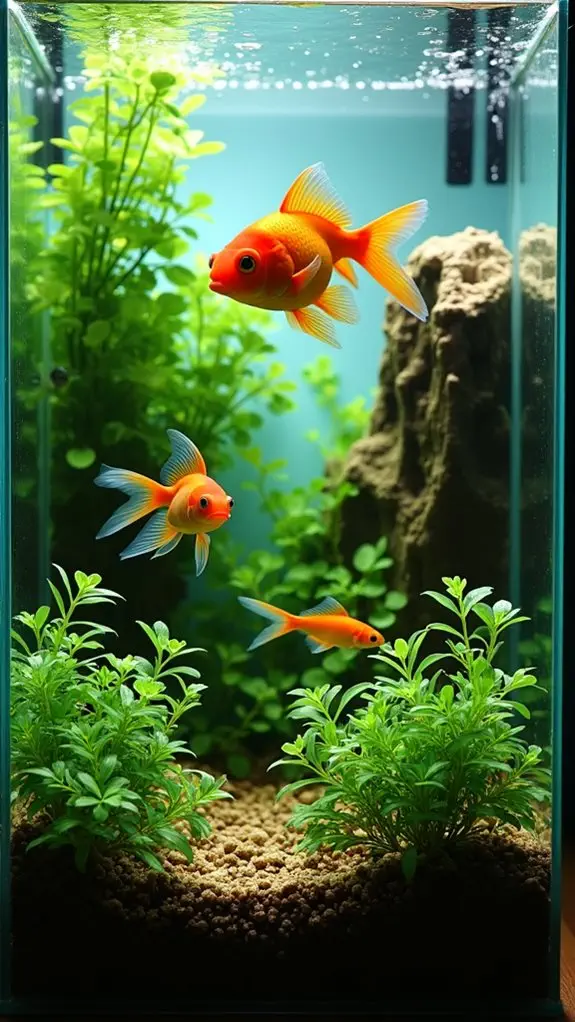
Three essential maintenance routines will determine the success of your guppy and goldfish cohabitation setup.
First, you'll need to maintain separate temperature zones, as guppies thrive in warmer waters (72-82°F) while goldfish prefer it cooler (68-74°F) – it's like trying to please both a sun-seeker and a snowbird!
Regular filter maintenance becomes your best friend in this setup. You'll want to establish a robust filtration system that can handle the goldfish's heavy waste production while ensuring it's not too powerful for your guppies. Clean your filter media weekly, and don't forget about those prefilter sponges – they're like tiny apartment buildings for beneficial bacteria.
Substrate cleaning is another vital task you can't skip. Weekly siphoning helps remove debris and maintains water quality for both species.
During water changes, remember to turn off all equipment and add water conditioner according to instructions. Keep an eye on your plants too – if you notice your goldfish treating them like an all-you-can-eat buffet, you might need to switch to more durable varieties.
Regular trimming of fast-growing plants will help maintain ideal water conditions for both species.
Frequently Asked Questions
Will Goldfish Eat Guppy Fry if They Breed in the Tank?
Yes, your goldfish will eat guppy fry due to their opportunistic breeding behavior. You'll need extensive fry protection measures like dense plants and hiding spots if you want any baby guppies to survive.
You shouldn't share medications between guppies and goldfish due to their different medication compatibility needs. Each species requires specific illness management approaches, and using the same treatment could harm either fish type.
Do Goldfish and Guppies Compete for Sleeping Spaces at Night?
You'll notice that goldfish and guppies do compete for sleeping spaces. Their different sleeping habits can clash, but you can minimize conflicts with proper tank layout including plenty of plants and hiding spots.
Should Guppies and Goldfish Be Introduced to the Tank Simultaneously?
You shouldn't introduce guppies and goldfish simultaneously. It's better to add the smaller guppies first, let them establish territories, then introduce goldfish later. This staged tank introduction timing reduces stress during acclimation.
Can Temperature Fluctuations Affect One Species More Than the Other?
Yes, temperature fluctuations affect guppies more severely than goldfish. You'll notice guppies have lower temperature tolerance, while goldfish show greater species resilience, adapting better to changes in their environment.
Final Thoughts
While guppies and goldfish might seem like a good match, you'll want to keep these fish in separate tanks. Their different temperature needs, space requirements, and behavioral patterns make them incompatible roommates. Instead, focus on creating species-specific environments where each can thrive. Your guppies will do better with tropical tank mates, while your goldfish will flourish with other cold-water fish that share their care requirements.

